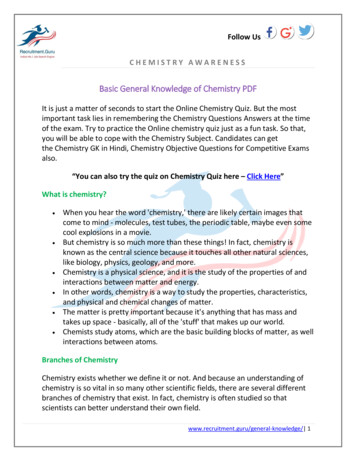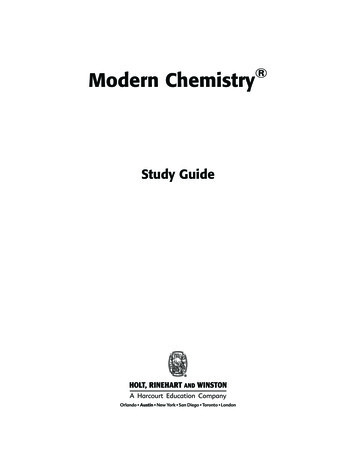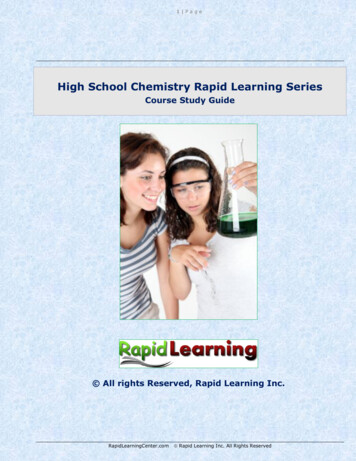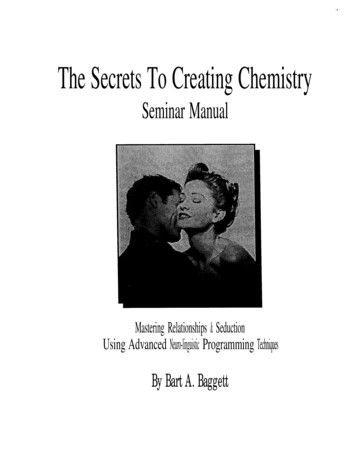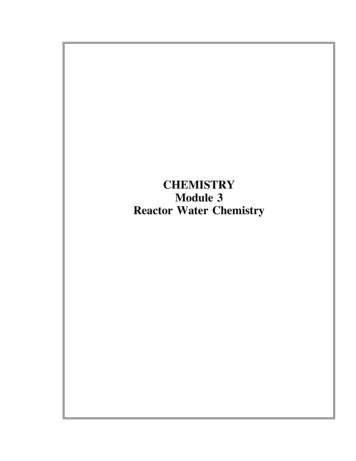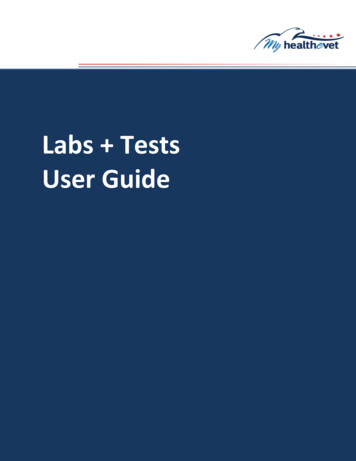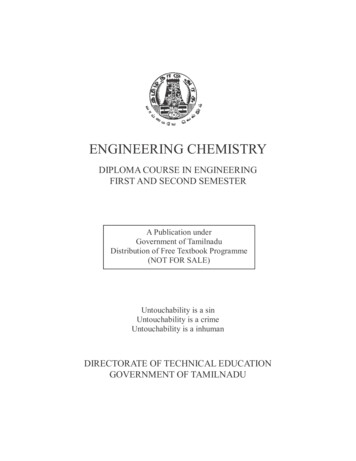
Transcription
ENGINEERING CHEMISTRYDIPLOMA COURSE IN ENGINEERINGFIRST AND SECOND SEMESTERA Publication underGovernment of TamilnaduDistribution of Free Textbook Programme(NOT FOR SALE)Untouchability is a sinUntouchability is a crimeUntouchability is a inhumanDIRECTORATE OF TECHNICAL EDUCATIONGOVERNMENT OF TAMILNADU
Government of TamilnaduFirst Edition – 2015Thiru. PRAVEEN KUMAR, I.A.S.,Principal Secretary /Commissioner of Technical EducationDirectorate of Technical EducationGuindy, Chennai- 600025.Dr.K.SUNDARAMOORTHY, M.E., Ph.D.,Additional Director of Technical Eduation (Polytechnics)Directorate of Technical EducationGuindy, Chennai- 600025ConvenerMrs.A.MeeraH.O.D (UG) / ChemistryDr. Dharmambal GovernmentPolytechnic College for WomenTharamani, Chennai—113Co-ordinatorEr. R.Sornakumar M.E.,PrincipalDr. Dharmambal GovernmentPolytechnic College for WomenTharamani, Chennai—113ReviewerProf.Dr.J.SANTHANALAKSHMIHead of the Department / Physical ChemistryUniversity of Madras, Chennai-25.AuthorsDr.K.Mohan M.Sc.,M.Phil.,Ph.D.,H.O.D (UG)/ ChemistrySakthi Polytechnic CollegeSakthinagar, Erode—638 315.THIRU.K.SUBRAMANIANH.O.D(UG)/ ChemistryP.T.LEE.C.N.Polytechnic College,Vepery, Chennai –600 technic CollegeThuvakudi, Trichy-22.THIRU.I.SYED AHAMED HUSSAINLecturer/ChemistryInstitute of chemical technologyTaramani, Chennai-113.THIRU.K.HEMACHANDRANSenior Lecturer/chemistryC.P.C.L.Polytechnic collegeManali, Chennai-68.This book has been prepared by the Directorate of Technical EducationThis book has been printed on 60 G.S.M PaperThrough the Tamil Nadu Text book and Educational Services Corporationii
FOREWORDWe are indeed very happy to present engineering chemistry book fordiploma engineers.Chemistry is the branch of science that deals with the study of matter,its composition, physical and chemical properties and applications.It is important for engineers to have knowledge of chemistry as thosemay face problems in fields as diverse as design and development of newmaterials, quality control and environmental engineering that are basicallychemistry oriented in nature.Chemistry is the backbone in designing and understanding the nature ofvarious engineering materials. Many advances in engineering andtechnology either produce a chemical demand like polymers, chemicaldevelopments for their application in powder metallurgy and alloys,preventing methods of pollution etc. Currently electronics and computerfield require biopolymers and nano materials. Electrical engineers requireproper conducting materials. Mechanical engineers are in search of microfluids and civil engineers are looking for environment friendly materials.This book in engineering chemistry is prepared for the studentsstudying I Year Diploma in Engineering and Technology in Tamilnadu. Thisbook is written in simple and easily understandable manner. Tabularcolumns, figures, and worked examples are given wherever necessary. Atthe end of each chapter, short answer questions and long answer questionsare given. Test your understanding questions are given wherever requiredwhich will motivate the students for further study.The authors are very much grateful to the Commissioner of TechnicalEducation Chennai for his deep involvement and encouragement inpreparing this syllabus and learning material. Thanks are due to officials ofDOTE, Chennai for their timely help whenever needed.Further suggestions and constructive criticisms for the improvement ofthis book are welcomeAUTHORSiii
30014 ENGINEERING CHEMISTRY – IDETAILED SYLLABUSContents: TheoryUnitIName of the TopicHoursATOMIC STRUCTURE, MOLECULAR MASS, ACIDS AND BASES1.1 Atomic Structure4 HrsAtom – Definition – Fundamental particles of Atom – their Mass, Chargeand Location – Atomic number and Mass number – Definition – Isotopesand Isobars – Definition with suitable examples – Formation of cation andanion by electronic concept of oxidation and reduction – Octet rule –Formation of electrovalent compound (NaCl) – Formation of covalentcompound (NH3).1.2 Molecular Mass4 HrsMolecule – Molecular Formula – Molecular Mass – Mole – Definition –Simple calculations – Avogadro’s Hypothesis – Relationship betweenMolecular Mass and Vapour Density – Avogadro Number – Definition.1.3 Acids and Bases5 HrsTheories of Acids and Bases – Arrhenius Theory – Lowry – BronstedTheory – Lewis Theory – Advantages of Lewis Theory – pH and pOH –Definition – Numerical problems – Indicator – Definition and Examplesonly – Buffer solution – Definition – Types of buffer solution with examples– Application of pH in Industries.IISOLUTIONS, COLLOIDS, NANO-PARTICLES2.1 Solutions4 HrsDefinition – Methods of expressing concentration of a solution – Molarity,Molality, Normality, Mole fraction and Percentage Mass – Simpleproblems.2.2 Colloids6 HrsTrue solution and Colloidal solution – Definition – Differences – Types ofcolloids – Lyophilic and Lyophobic colloids – Differences – Properties –Tyndall effect, Brownian movement, Electrophoresis and Coagulation –Industrial applications of colloids – Smoke Precipitation by Cottrell’smethod, Purification of water, Cleansing action of soap, Tanning of leatherand Sewage disposal.2.3 Nano-ParticlesDefinition – Importance of Nano-particles – Area of application – Medicine,Electronics and Biomaterials.3Hrs
UnitIIIName of the TopicTECHNOLOGY OF WATER, CATALYSIS, GLASSHours3.1 Technology of Water6 HrsSources of water – Reasons for depletion of underground water – Rainwater harvesting (Basic ideas) – Advantages – Hard water and soft water– Hardness of water – Carbonate and Non-carbonate hardness –Methods of expressing hardness – mg/lit and ppm – Simple problems –Estimation of total hardness of water by EDTA method – Problemsinvolving Total, Carbonate and Non-carbonate hardness in ppm –Softening of hard water – Ion-Exchange method and Reverse Osmosismethod – Municipal water supply – Purification (Sedimentation, Filtrationand Sterilization) – Disadvantages of using hard water in boilers – Scaleformation, Corrosion of boiler metal, Caustic Embrittlement and Primingand Foaming.3.2 Catalysis4 HrsCatalyst – Positive catalyst – Negative catalyst – Definition – Types ofcatalysis – Homogeneous and Heterogeneous – Promoter – Catalystpoison – Definition – Characteristics of a catalyst – Industrial applicationsof catalysts.3.3 Glass3 HrsDefinition – Manufacture of Glass – Varieties of Glass – Optical Glass,Windshield Glass and Photo chromatic Glass.IVELECTROCHEMISTRY, ELECTROCHEMICAL CELL, ENERGYSOURCES4.1 Electrochemistry5 HrsElectrolyte – Definition – Strong and Weak electrolytes – Examples –Electrolysis – Definition – Mechanism – Industrial application ofElectrolysis – Electroplating – Preparation of surface – Process – Factorsaffecting the stability of the coating – Chrome plating – Electroless plating– Definition – Advantages of Electroless plating over electroplating –Applications of Electroless plating.4.2 Electrochemical Cell4 HrsElectrochemical Cell – Definition – Representation of a Cell – SingleElectrode Potential – Definition – Galvanic Cell – Formation of Daniel Cell– Electrochemical Series – Definition and Significance – ElectrolyticConcentration Cell – Definition and Formation.4.3 Energy SourcesPrimary Battery – Definition and example – Construction, Working andUses of Dry cell – Secondary Battery – Definition and example –Construction, Working and Uses of Lead-acid Storage Cell –Nonconventional Energy Sources – Solar Cell – Definition – Principle,Construction, Working and Uses.4 Hrs
UnitVName of the TopicHoursCORROSION, METHODS OF PREVENTION OF CORROSION,ORGANIC COATINGS5.1 Corrosion4 HrsDefinition – Types of Corrosion – Theories of corrosion – Galvanic CellFormation Theory – Differential Aeration theory – Factors influencing therate of corrosion.5.2 Methods of Prevention of Corrosion4 HrsControl of Environment – Alloying – Surface coatings – Metal coatings –Electroplating, Galvanization and Tinning – Inorganic coating – Anodizing– Cathodic Protection – Sacrificial Anode Method and Impressed VoltageMethod.5.3 Organic Coatings5 HrsPaint – Definition – Components of Paints and their functions – Varnish –Definition – Preparation of Oil Varnish – Differences between Paint andVarnish – Special Paints – Luminescent Paints, Fire Retardant Paints,Aluminium Paints and Distemper.Text Book:1. Engineering Chemistry – I Tamil Nadu Text Book Corporation2. Engineering Chemistry – Jain & Jain – Dhanpat Rai & Sons.3. A Text Book of Engineering Chemistry – S.S. Dara – S. Chand Publication.Reference Book:1. A Text Book of Environmental Chemistry and Pollution Control S.S. Dara – S. ChandPublication.2. Engineering Chemistry – Uppal – Khanna Publishers.3. Chemistry – Higher Secondary – Second Year – Volume I & II – Tamil Nadu Text BookCorporation – 2014.4. Environmental Chemistry – V P Kudesia – Pragati Publishers.--oOo--
30025ENGINEERING CHEMISTRY – IIDETAILED SYLLABUSContents: TheoryUnitIName of the TopicHoursENVIRONMENTAL CHEMISTRY1.1 Air Pollution5 HrsPollution and Air pollution – Definition – Air pollutants (SO2, H2S, HF, COand Dust) – Sources and Harmful effects – Formation of Acid Rain –Harmful effects – Green House Effect – Causes – Global warming –Harmful effects – Ozone Layer – Importance – Causes for Depletion ofOzone Layer (No equations) – Harmful effects of Ozone Layer Depletion– Control of Air Pollution.1.2 Water Pollution4 HrsCauses of Water Pollution – Sewage, Effluents, Algae andMicroorganisms – Harmful effects –Sewerage – Definition – SewageDisposal – Industrial Effluents – Harmful effects of Effluents – Harmfuleffects of Heavy Metal Ions – Lead, Cadmium, Zinc and Copper –Treatment of Effluents – Eutrophication – Definition and harmful effects.2 Hrs1.3 Solid Waste ManagementSolid Waste – Definition – Problems – Types of Solid Waste – Methods ofdisposal – Land fill and Incineration.2 Hrs1.4 Green ChemistryDefinition – Goals of Green Chemistry (Basic ideas) – Recycling –Definition – Examples – Advantages of Recycling (Basic ideas)IIFUELS, COMBUSTION AND REFRACTORIES2.1 Fuels6 HrsFuel and fossil fuel – Definition – Calorific value – Classification of fuels –Solid fuels – Wood – Coal – Varieties of Coal – Composition – Specificuses – Liquid fuels – Petroleum – Fractional distillation – Fractions anduses – Cracking (Concept only) – Liquid Hydrogen as fuel – Gaseousfuels – Preparation, composition and specific uses of Producer gas andWater gas – Composition and uses of CNG and LPG – Relativeadvantages of solid, liquid and gaseous fuels.2.2 Combustion5 HrsDefinition – Combustion calculation by mass (for solid and liquid fuels) –Combustion calculation by volume (for gaseous fuels) – Stoichiometriccalculations – Volume of air required – Excess air – Definition of Flue gas– Flue gas Analysis – Orsat Apparatus – Simple numerical problems.2.3 RefractoriesDefinition – Requirements of a good Refractory – Classification – Acidic, 2 HrsBasic and Neutral Refractories – Examples and uses – Uses of Fireclaybricks, Alumina bricks and Silica bricks.
UnitIIIName of the TopicHoursEXTRACTION OF METALS, POWDER METALLURGY, ALLOYS ANDABRASIVES3.1 Extraction of metals2 HrsExtraction of Tungsten and Titanium – Uses of Tungsten and Titanium.3.2 Powder metallurgy3 HrsDefinition – Preparation of Metal Powder – Atomization – Reduction ofMetal Oxide – Applications of Powder Metallurgy.3.3 Alloys4 HrsDefinition – Purpose of alloying – Types – Ferrous Alloys – Compositionand uses of Stainless Steel, Chromium Steel and Vanadium Steel – Nonferrous alloys – Composition and uses of Nichrome, Dutch metal,German silver, Gun metal and Duralumin.3.4 Abrasives4 HrsDefinition – Classification – Hardness in Moh’s scale – Natural abrasives– Diamond, Corundum, Emery and Garnet – Synthetic abrasives –Carborundum – Boron carbide – Manufacture – Properties and uses.IVCEMENT, CERAMICS, LUBRICANTS AND ADHESIVES4.1 Cement3 HrsDefinition – Manufacture of Portland Cement – Wet Process – Setting ofCement (No equation).4.2 Ceramics3 HrsWhite pottery – Definition – Manufacture of White pottery – Uses –Definition of glazing – Purpose – Method – Salt glazing.4.3 Lubricants3 HrsDefinition – Characteristics of Lubricant – Types of Lubricants – Solid –Semi-solid –Liquid Lubricants .4.4 AdhesivesDefinition – Requirements of good adhesives – Natural adhesive – Usesof Shellac, Starch, Asphalt – Synthetic adhesive – Uses of CelluloseNitrate, PVC, Phenol-formaldehyde and Urea-formaldehyde.4 Hrs
UnitVName of the TopicHoursPOLYMERS6 Hrs5.1 PlasticsPlastics – Definition - Polymerization – Definition – Types ofpolymerization – Addition polymerization – Formation of Polythene –Condensation polymerization – Formation of Bakelite – Types of plastics– Thermoplastics and Thermoset plastics – Differences – Mechanicalproperties of plastics – Advantages of plastics over traditional materials(Wood and Metal) –Reinforced or filled plastics – Definition – Advantages– Applications – Polymers in Surgery – Biomaterials – Definition –Biomedical uses of Polyurethane, PVC, Polypropylene and Polyethylene.5.2 Rubber5 HrsDefinition – Preparation from Latex – Defects of natural rubber–Compounding of rubber – Ingredients and their functions – Vulcanization– Definition and Purpose – Reclaimed rubber – Definition – Process –Properties and uses.5.3 Composite materials2 HrsDefinition – Examples – Advantages over metals and polymers – Generalapplications.Text Book:1. Engineering Chemistry – Jain & Jain – Dhanpat Rai & Sons.2. A Text Book of Engineering Chemistry – S.S. Dara – S. Chand Publication.Reference Book:1. Chemistry of Engineering Material-C.V. Agarwal, Andranaidu C. Parameswara Moorthy –B.S. Publications.2. Engineering Chemistry – Uppal – Khanna Publishers.3. A Text Book of Inorganic Chemistry – P.L. Soni – S. Chand Publication.4. Rain Water Harvesting – Hand Book – Chennai Metro Water.--oOo--
Board Examination - Question paper patternTime: 3 Hrs.Max.Marks: 75PART A - 5 Questions to be answered out of 8 for 2 marks each.PART B - 5 Questions to be answered out of 8 for 3 marks each.PART C- All the 5 Questions to be answeredEach question in PART C will contain 3 Sub questions, out of these 3 Sub questions 2 Sub questionsis to be answered for 5 marks each.PART A5 x 2 marks10 MarksPART B5 x 3 marks15 Marks5 x 2 x 5 marks50 MarksShort answer type questionsPART CDescriptive answer type questionsEach question in PART C will contain 3 Sub questions,out of these 3 Sub questions 2 Sub questions is to beanswered for 5 marks each.Total75 MarksOut of the 3 Sub questions in PART C, one sub question must be on problem based totest the analytical ability/logical ability /diagnostic ability/conceptual ability relevant to that subjectcontent. Equal weightage is to be given to whole syllabus.Clarks table will not be permitted for the Board Examinations.
CONTENTSFIRST SEMESTERUNITCONTENTSUNIT-IATOMIC STRUCTURES, MOLECULAR MASS, ACIDS AND BASESPage No1.1Atomic structure011.2Molecular Mass091.3Acids and Bases16UNIT-IISOLUTIONS, COLLOIDS, NANO es40UNIT-III TECHNOLOGY OF WATER CATALYSIS AND GLASS3.1Technology of water423.2Catalysis563.3Glass60UNIT-IV ELECTROCHEMISTRY, ELECTROCHEMICAL CELL AND ENERGY RESOURCES4.1Electrochemistry634.2Electrochemical cell694.3Energy Resources75UNIT-VCORROSION, METHODS OFPREVENTION OF CORROSION AND ORGANICCOATINGS5.1Corrosion815.2Methods of Prevention of corrosion895.3Organic Coatings96ENGINEERING CHEMISTRYPRACTICAL -I SYLLABUS AND PROCEDURE102x
SECOND SEMESTERUNITUNIT-ICONTENTSPage NoENVIRONMENTAL CHEMISTRY1.1Air Pollution1421.2Water Pollution1491.3Solid Waste Management1541.4Green Chemistry158UNIT-IIFUELS,COMBUSTION ories184UNIT-III EXTRACTION OF METALS, POWDER METALLURGY ALLOYS ANDABRASIVES3.1Extraction of metals1873.2Powder metallurgy1913.3Alloys1943.4Abrasives198UNIT-IV CEMENT, CERAMICS, LUBRICANTS AND ber2225.3Composite materials226ENGINEERING CHEMISTRY PRACTICAL-II SYLLABUS AND PROCEDURE228FIRST AID FOR ACCIDENTS IN CHEMISTRY LABORARTORIES249xi
ENGINEERINGCHEMISTRY-IFIRST SEMESTERUNIT-IATOMIC STRUCTURES, MOLECULAR MASS, ACIDS ANDBASES1.1 ATOMIC STRUCTUREINTRODUCTIONChemistry is a branch of science that deals with the study of thenature of matter, its composition, occurrence, isolation, methods ofpreparation, properties and uses.An atom is the smallest form of a chemical particle that retains theproperties of the particle. The word 'atom' comes from the Greek word'atomos', meaning 'unable to be cut'. The original meaning of atom was thesmallest, indivisible form of a chemical particle. Now we know how to divideatoms into sub-atomic particles, the definition of an atom includes the conceptthat the particle must retain its chemical properties.ATOMAn Atom is the smallest invisible particle of element, having all thecharacteristics of the parent element, which can neither be created nordestroyed by any chemical change. It cannot exist freely. It is the ultimateparticle of an element, which may or may not have independent existence.The atoms of certain elements such as hydrogen, oxygen, nitrogen,etc.do not have independent existence where as atoms of helium, neon,argon, etc. do have independent existence. All elements are composed ofatoms.Fundamental particles of an atomAlmost the atoms of all elements are made up of three main particles knownas fundamental particles. They are electrons, protons and neutrons. Hydrogenis the only element that do not have neutron.PROTON1.The proton is a positively charged particle.2.It has unit positive charge and unit mass. The mass of proton isapproximately equal to the mass of one hydrogen atom. It is equal to1.00732 amu.3.The proton is present in atoms of all the elements.4. he protons are present inside the nucleus of an atom.
ELECTRON1. The electron is a negatively charged particle.2. It has unit negative charge and negligible mass.3. The mass of and electron is about 1/1837 of mass of a hydrogen atom.4. Electrons are present in all the atoms.5. Electrons are revolving around the nucleus in various circular orbits (shell).NEUTRON1. The neutron is a neutral particle. Hence, it has no charge.2. It has unit mass. The neutron is present in atoms of all elements excepthydrogen. The mass of a neutron is slightly greater than the mass of aproton. It is equal to 1.00871 amu.3. Neutron is present inside the nucleus of an atom.ATOMIC NUMBER (Z)The atomic number is the number protons present in the nucleus of anatom or number of electrons revolving around the nucleus in anatom. Based on the carbon standard the atomic mass of an element maybe defined as the ratio between the mass of one atom of the element andth1/12 of mass of an atom of carbonAtomic number No of protons No of electronsMASS NUMBER (A)The mass number of an element is given by the total number of protons andneutrons present in the nucleus of an atom. A (P N)Therefore the number of neutrons is A-Z.ISOTOPESThe isotopes are atoms of the same elements having the same atomicnumber but different mass number.e.g. Isotope of oxygen: 8O16, 8O17, 8O18.ISOBARIsobars are the atoms of different elements having the same mass numberbut different atomic number.e.g. 92U234, 91Pa234.STRUCTURE OF ATOMThe atom consists of two parts. They are 1.The central nucleus 2.The outerextra nuclear part.1. The central Nucleus:The nucleus is the central part of an atom consists of protons and neutrons.Since the protons are positively charged particle and neutrons are neutral, thenucleus is always positive part of an atom. The entire weight of an atom ispresent only in the nucleus.2
2. The outer extra nuclear part.1. It is the part around the nucleus. It contains all electrons of an atom. Itis the negative part of the atom. The electrons are revolving around thenucleus in a regular path called shell or orbit or energy levels.2. The shells or orbits are numbered, as 1,2,3,4 etc from the nucleus.They are also known as K, L, M, N Shell or orbit.3. Each shell can accommodate only certain number of electron, which isgiven by the formula 2n2 where the ‘n’ is the number of the shell.Therefore, the numbers of electrons that are accommodated in the 1st,2nd, 3rd shell respectively are 2,8,18.4. The electrons present in the outer most orbit is called as valenceelectron.5. The atom as whole is a neutral one. Since the number of protons(positively charges) is equal to the number of electrons (negativecharges).The atomic structure of Sodium atom is given below.FORMATION OF CATION AND ANIONExample.11. Hydrogen atomNumber of proton 1 (number of positive charge is 1)Number of electron 1 (number of negative charge is -1)Number of neutron 0--1 ELECTRON1P1e1P Hydrogen ion (H ) or protonHydrogen atom3
So, Z 1 , A 1When hydrogen atom losses its outer most electron, it has only one proton. The H becomes H ion due to the loss of one electron. Hence, the H ion iscalled as proton. HH (proton) 1eA-Z 1-1 0(No neutron)FORMATION OF CATION AND ANIONAtom as whole is a neutral one, since the number of proton and electrons areequal. An atom becomes an ion only when there is a gain or loss of anelectron. Anion (-ve ion) is formed by the gain of electron. Similarly, cation(positive) is formed by the loss of electron.CATION FORMATION Na (Atom) -1eNa (cation).When an atom losses an electron it becomes cation. When electron istransferred from sodium atom to chlorine atom the sodium atom becomescation.ANION FORMATIONWhen an atom gains an electron, it becomes anion. From the above example,chlorine atom gains an electron from sodium it becomes an anion. Cl (Anion)Cl (Atom) 1eELECTRONIC CONCEPT OF OXIDATION AND REDUCTIONThe electronic concept of oxidation and reduction can be explained as below.OXIDATIONOxidation is a process that involves removal (loss) of electrons.Example:Na-1e-Na 4
-1e-K-K -1eHH Here Na, K and H are oxidised into Na , K and H respectively.REDUCTIONReduction is a process that involves addition (gain) of electrons.Example: Cl 1eFF 1eBrBrHere Cl, F and Br are reduced into Cl- , F- and Br – respectively.What is chemical bonding?When two atoms in a molecule strongly tend to remain together, theyare said to be in chemical bonding with each other. In other words, it is saidthat a chemical bond has been established between the two atoms. Thus,“A chemical bond may be defined as an attraction between thetwo atoms in a molecule” 1e-ClWhy do atoms combine?There is a deep relationship between the properties and the electronslying in their outermost orbits. The elements having same number of valencyelectrons have similar properties. The elements in the zero groups have twoor eight electrons are inactive chemically.OCTET RULEThe inert gases have the stable configuration of eight electrons (octetstructure) in their outer most orbits except helium which 2 have only electrons.Due to their stable octet structure, these gases are inert in nature. They donot chemically react with other elements. ”According to Lewis “octet theory,all the elements with an unstable or incomplete electronic configurationhave a tendency to attain the stable electronic configuration of thenearest inert gas configuration either by complete transfer of valenceelectron from one atom to another or by mutual sharing of valenceelectron between the atoms”. This tendency to attain the stable electronicconfiguration is responsible for the formation of chemical bonding.INERT GASES OR NOBLE GASESElementAtomic numberElectronic configurationHelium22 (H-1 unstable-for on542,8,18,18,8Radon862,8,18,32,18,85
TYPES OF BONDINGThe process by which unstable atoms acquire a stable configuration has beenfound to take place in two different ways.1. The complete transfer of valency electrons from one atom to another.This is called Ionic bond (or) Electrovalent bonding.2. The mutual sharing of (pair of) valency electronsbetweentheatoms. The shared pair of electrons is given by both atoms. This is calledas Covalent bonding.Ionic (or) Electrovalent BondThis type of bond is formed as a result of the complete transfer of oneor more electrons from one atom to other.This bond is generally present in inorganic compoundsExample: Formation of Sodium ChlorideExplanation :The atomic number of sodium is 11(11P/11e 11 /11- )The electronic configuration is 1s2, 2s2, 2p6, 3s1(2, 8, 1).The electron dot formula is Na.Sodium has only one electron in its outermost orbital.The atomic number of chlorine is 17(17p/17e 17 /17- )The electronic configuration is 1s2, 2s2, 2p6, 3s2, 3p5 (2, 8, 7)The electron dot formula isCl6
Sodium has one electron in excess of the stable neon configuration (2, 8).and chlorine is one electron short of the stable argon configuration (2, 8, 8).When these atoms are in contact, sodium has a tendency to lose its singlevalence electron and chlorine has a tendency to accept a single electron toreach the stable electronic configuration of the nearest inert gas. Bytransferring one electron from sodium to chlorine, sodium acquires a unitpositive charge while by gaining the electron; the chlorine atom acquires aunit negative charge.Now sodium has attained the stable electronic configuration of neon(2,8).Similarly chlorine has attained the stable electronic configuration ofneon(2,8,8).These charged ions are held together by electrostatic attraction and form aneutral molecule of sodium chloride.Compounds formed in this way are called electrovalent or ioniccompounds and the bond is called Ionic bond or electrovalent bond.Covalent bondFormation of a covalent compound(NH3)This type of bond is formed by the mutual sharing of pair of electronsbetween two atoms each atom supplying equal number of electrons forsharing. The covalent bond is indicated by (-).Example: Formation of Ammonia (NH3 ).Explanation :HHNHHHHNHHThe atomic no of Nitrogen is 7. (E.C:2, 5 unstable)The electronic configuration 1s2,2s2,2p3.The electron dot formula of N is7NH
The electron dot formula is H.The atomic number of Hydrogen is 1.The electronic configuration 1s1(E.C:1 unstable)To get stable electronic configuration Nitrogen shares its three electrons withelectrons of three Hydrogen atoms.Ammonia is formed by the covalent bonding between one atom ofhydrogen and three atoms of hydrogen. Nitrogen has five valence electrons.The electronic configurationis2,5(unstable). Therefore, it needs threeelectrons to attain stable inert gas configuration. Hydrogen has one electron.So it needs one electron to attain the stable inert gas configuration of Helium.The nitrogen atom shares three of its valence electron with three hydrogenatom forming the covalent bonds.All the four atoms attain the stable configuration. Thus, the covalent bond isformed.QUESTIONSPART-A1. What is the charge of a nucleus of an atom?2. Define isotopes3. Define isobars4. What is the charge of an anion?5. What is the charge of a cation?6. Define oxidation7. Define reductionPART-B1. We can call H ion as a proton. How?2. Atomic number and mass number of an element is 9 & 19 respectively.What is the number of neutrons present in the atom of the element?3. Explain the formation of a cation with example?4. Explain the formation of an anion with example?PART-C1. Why do atoms of elements combine?2. Which is more stable Na or Na Why?3. Explain the formation of NaCl?4. Explain the formation of NH3?5. While atoms of most of the elements are unstable but atoms of noble gasesare stable. Explain?6. Which is more stable Cl or Cl- Why?8
1.2. MOLECULAR MASSIntroductionChemistry is chiefly concerned with atoms and molecules and theirinteractions and transformations, for example, the properties of the chemicalbonds formed between atoms to create chemical compounds or molecule. Assuch, chemistry studies the involvement of electrons and various forms ofenergy in chemical reactions.Molecule:A Molecule is the smallest particle of matter(element or a compound)that can exit freely. The molecule is made up of two or more atoms of thesame element or different elements. It can be further divided into atoms.Types of molecules:Molecules are of two types1. Homoatomic molecules2. Heteroatomic molecules1. Homoatomic moleculeThe molecule is made up of two or more atoms of the same elements.Molecules of Chlorine(Cl2), Oxygen(O2), and Hydrogen(H2) contain onlytwo atoms of same kind. So they are called as Homoatomic molecules.HHH2AtomAtomOOMoleculeO2Most of the elementary gases consist of homoatomic molecules.For example hydrogen gas consists of two atoms of hydrogen (H2).Similarlyoxygen gas consists of two atoms of oxygen (O2).In accordance with the number of atoms present in these molecules they areclassified as mono atomic, di-atomic, tri-atomic and polyatomic moleculesshowing that they contain one, two, three, or more than three atomsrespectively.2. Heteroatomic moleculesThe molecule is made up of more than two of more atoms of differentelements. Thus in the molecule of carbon dioxide one atom of carbon & twoatoms of oxygen have united. Hence, it is called as Heteroatomic molecules.9
OCOCO2MOLECULAR FORMULAMolecular formula is the short form of representation (symbolical) ofone molecule of an element or a compound.Example:Molecular formula of Oxygen is O2 (element.).Molecular formula of water is H2O (compound)Significance of molecular formula1. It shows the elements present in one molecule.2. It gives the exact number of atoms present in one molecule.3. It is used to calculate the molecular mass of a molecule.MOLECULAR MASS:Molecular mass of an element or a compound is the ratio between themass of one molecule of the element or the compound and the mass of 1/12part of a carbon Atom.MolecularMass of an Mass of one molecule of an element or compoundElement /1/12 part by mas
fluids and civil engineers are looking for environment friendly materials. This book in engineering chemistry is prepared for the students studying I Year Diploma in Engineering and Technology in Tamilnadu. This book is wr




